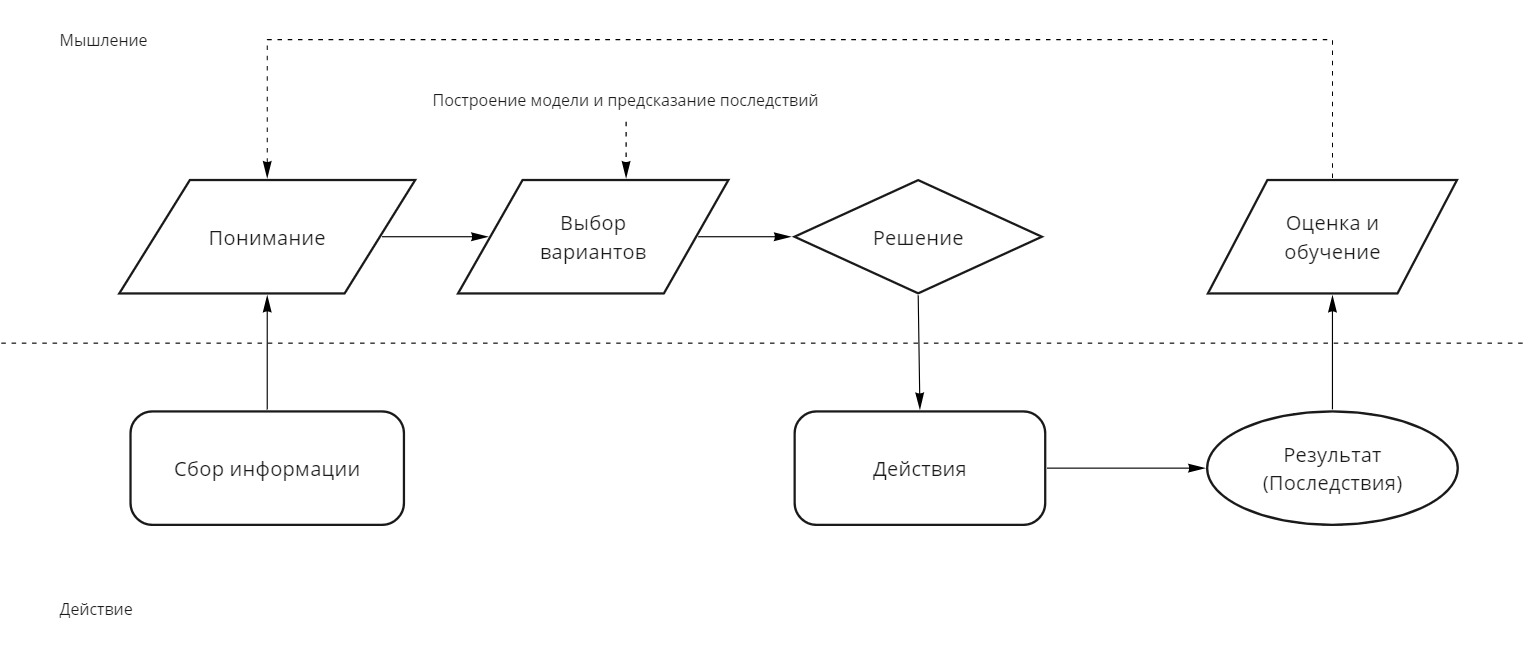Results Discussions on the topic: Personal, Team and Organizational Thinking ”(LAF 2018)
In my search for an answer on how to make the best strategic decisions (and at the same time prove that it is useful to think), I came across two key ideas that do not bother me, because they turn over all the classic ideas about how decisions are made:
In this context, I really wanted to use the collective mind in order to clarify what “Thinking” is and why it is needed.
Within the framework of the initial discussion, an understanding was formed that in the context of group thinking, a perspective is best suited in which thinking is a process that determines the effectiveness of decision making. A slightly modified scheme is shown in the figure.

')
So in our narrow circle, we agreed to understand by thinking the process on which the consequences of the actions taken ultimately depend. Remarkably, just as with an individual, the group has a conscious decision-making process and an unconscious choice.
In the transition to the characteristics of thinking and how to develop it, I spoke about the three archetypes of thinking supported at the genetic level and associated with the evolution of individual thinking:
As it was heard Maxim Tsepkov can be read here .
(My memory tells me that I grasped the essence in one of the Stanford lectures on neurobiology or design thinking, but the exact link was not preserved. If someone finds out the source I will be grateful).
In addition, thanks to the thoughtful and interesting comments of the group, we picked up a few more terms in order to characterize thinking:
PS: Why is awareness needed? If only because there are so many situations and solutions in the world that are “Counterintuitive”. This is, as always, a pawn neatly substituted by the opponent.
References:
- The subject of thinking is not an individual, but a group. (David Clutback's Level 2 Team Coaching Course)
- 3 levels of thinking from the Integrated Thinking Framework (Richard King):
Personal, team, organizational.
In this context, I really wanted to use the collective mind in order to clarify what “Thinking” is and why it is needed.
Within the framework of the initial discussion, an understanding was formed that in the context of group thinking, a perspective is best suited in which thinking is a process that determines the effectiveness of decision making. A slightly modified scheme is shown in the figure.

')
So in our narrow circle, we agreed to understand by thinking the process on which the consequences of the actions taken ultimately depend. Remarkably, just as with an individual, the group has a conscious decision-making process and an unconscious choice.
In the transition to the characteristics of thinking and how to develop it, I spoke about the three archetypes of thinking supported at the genetic level and associated with the evolution of individual thinking:
- “Collector” - Reinforcement through the result,
- “Hunter” - Reinforcement through the process,
- “Great builder” - reinforcement when a multi-pass combination is added up.
As it was heard Maxim Tsepkov can be read here .
(My memory tells me that I grasped the essence in one of the Stanford lectures on neurobiology or design thinking, but the exact link was not preserved. If someone finds out the source I will be grateful).
In addition, thanks to the thoughtful and interesting comments of the group, we picked up a few more terms in order to characterize thinking:
- The breadth of thinking . The number of aspects / factors that are considered in the analysis.
Chess example: Aspect # 1 - I will eat this pawn (Winning a piece)
Aspect # 2 - Development Opportunities (Dual Pawn)
Aspect # 3 - Alternatives (Eat Queen?) - Logic Order / Calculation Depth . How many moves / chain of effects is being analyzed.
Chess example: 1st order logic - I will eat this pawn
2nd order logic - He will eat my horse
3rd order logic - I will take his boat, etc. - Scale. The object for which we evaluate the consequences.
For example: Personal, For the team, for the department ... Country, World ...
A chess example is not suitable here, because in chess, the scale can be represented as one simple example of the number of factors being analyzed.
PS: Why is awareness needed? If only because there are so many situations and solutions in the world that are “Counterintuitive”. This is, as always, a pawn neatly substituted by the opponent.
References:
Source: https://habr.com/ru/post/417977/
All Articles